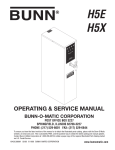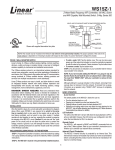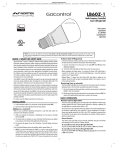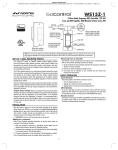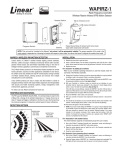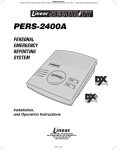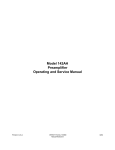Download Linear wt00z-1 User's Manual
Transcript
WT00Z-1 Radio Frequency (RF) Controlled, 120 VAC, Wall Mounted Transmitter, Series 300 NEUTRAL 120 VAC WHITE BLACK LINE TO MOUNT MORE THAN ONE WT00Z-1IN A BOX, SCORED TAB WILL BREAK FLUSH WITH EDGE OF PLASTIC PUSH TOP OR BOTTOM OF PADDLE SWITCH ONCE TO INCLUDE IN NETWORK PUSH ON (PUSH & HOLD TO BRIGHTEN) PUSH OFF (PUSH AND HOLD TO DIM) GREEN GROUND STATUS LED SUPPLIED WITH DECORATIVE SWITCH PLATE NOTE: This module must be “included in the Network” only where it will be permanently installed. The proper operation of this node in the mesh network is dependent on it knowing its location with respect to other nodes. You cannot “test bench” configure this module. WTOOZ-1 WALL MOUNTED TRANSMITTER INCLUDING WT00Z-1 TO THE NETWORK Linear’s family of Z-Wave certified wireless lighting controls (switches, dimmers, outlets and plug-in modules) brings a new level of intelligent wireless capability to commercial and residential environments. STEP 1. Prepare the Controller to include a unit to the network by adding it to a group (method of adding a node to the network). Refer to controller instructions. The Z-Wave wireless protocol is an international wireless standard for remote home automation, security and other applications. Embedded in each device, the Z-Wave smart chip enables two-way RF communication among hundreds of Z-Wave enabled devices, allowing products and services from multiple manufacturers to work seamlessly. STEP 2. The WT00Z-1 must be in its permanently installed location. Tap either the top or bottom of the WT00Z-1 once. STEP 3. You should see an indication on your Controller that the “device was included” in the network. NOTE: If you have trouble adding the WT00Z-1 to a group it may be that the Home ID and Node ID were not cleared from it after testing. You must first “RESET UNIT” with your controller to remove it from the network. Although adding it to a group includes it in the network, removing it from a group does not remove it from the network. If removed from a group, it functions as a repeater (only). “RESET UNIT” removes it completely from the network. Linear Z-Wave products are easy to install, and allow dealers to create an integrated wireless network with nearly limitless expansion and interoperability with security and health monitoring systems, energy management, home entertainment, appliances, and more. INSTALLATION DANGER! SHOCK HAZARD. Read and understand these instructions before installing. This device is intended for installation in accordance with the National Electric code and local regulations in the United States, or the Canadian Electrical Code and local regulations in Canada. It is recommended that a qualified electrician perform this installation. Retain instructions for future use. With power off, wire this WT00Z-1 according to the diagram shown above. If more than one WT00Z-1 is to be installed in a wall box, scored tabs on the side can be broken off by bending back and forth with pliers, to accommodate proper fit. Apply power when completed. Refer to your Controller operating instructions on how to include this module in the RF network 1 OPERATION CONFIGURATION Before you can control Z-Wave devices you must associate the devices you want to control from the WT00Z-1. The WT00Z-1 supports the Configuration command. The WT00Z-1 simulates the operation of a dimmer. Using configuration commands you can adjust the dimming parameters as though it were a dimmer. The WT00Z-1 can be configured to operate slightly differently than how it works when you first install it. Using the configuration command you can change operational characteristics. Turning Z-Wave devices On or Off 1. Tap the top of the paddle to turn On Z-Wave devices. 2. Tap the bottom of the paddle to turn Off Z-Wave devices. The LED on the WT00Z-1 will indicate the status of the devices you are controlling. The LED on the WT00Z-1 will flicker when it is transmitting commands to any of the four groups. This can be changed. See “LED Transmission Indication”. Set Ignore Start Level Bit When Transmitting Dim Commands The WT00Z-1 can send Dim commands to Z-Wave enabled dimmers. The Dim command has a start level embedded in it. A dimmer receiving this command will start dimming from that start level. However, the command can be sent so that the dimmer ignores the start level and instead starts dimming from its current level. By default, the WT00Z-1 sends the command so that the dimmer will start dimming from its current dim level rather than the start level embedded in the command. To change this, simply set the configuration parameter to 0. Dimming and Brightening 1. Press and hold the top of the paddle to brighten Z-Wave enabled dimmers. 2. Press and hold the bottom of the paddle to dim Z-Wave enabled dimmers. • Parameter No: 1 • Length: 1 Byte • Valid Values = 0 or 1 (default 1) Associating Z-Wave devices to control from the WT00Z-1 Refer to your controllers instructions to find out how to associate Z-Wave devices. You can associate another Z-Wave device into any or all of the 4 available groups in the WT00Z-1. The four groups are described below: NOTE: Any ACT Z-Wave enabled dimmers have the configuration option to ignore the start level no matter how you configure the WT00Z-1 Group 1 Nodes in this group are turned ON by tapping the top of the paddle or OFF by tapping the bottom of the paddle. Nodes associated into this group are dimmed by pressing and holding the bottom of the paddle until the desired dim level is reached or brightened by pressing and holding the top of the paddle until the desired level is reached. Suspend Group 4 You may wish to disable transmitting commands to Z-Wave devices that are in Group 4 without “un-associating” those devices from the group. Setting parameter 2 to the value of 1 will stop the WT00Z-1 from transmitting to devices that are “associated” into Group 4. • Parameter No: 2 • Length: 1 Byte • Valid Values = 0 or 1 (default 0) The LED on the WT00Z-1 will indicate the status of this group ONLY. NOTE: Associating nodes into group 2 or 3 will cause a very slight delay before the command is transmitted to group 1. Night Light The LED on the WT00Z-1 will by default, turn ON when the status of the devices in Group 1 is ON. To make the LED turn ON when the status of Group 1 is OFF set this parameter to a value of 1. Group 2 Nodes in this group are turned ON by tapping the top of the paddle twice or OFF by tapping the bottom of the paddle twice. Nodes associated into this group are dimmed by tapping the bottom of the paddle once and then pressing and holding the bottom of the paddle until the desired dim level is reached or brightened by tapping the top of the paddle once then pressing and holding the top of the paddle until the desire level is reached. • Parameter No: 3 • Length: 1 Byte • Valid Values = 0 or 1 (default 0) Invert Switch To change the top of the transmitter to OFF and the bottom of the transmitter to ON, set parameter 4 to 1. To change back to original settings, set this parameter to the value of 0. Group 3 Nodes in this group are turned ON by tapping the top of the paddle three times or OFF by tapping the bottom of the paddle three times. Nodes associated into this group are dimmed by tapping the bottom of the paddle twice and then pressing and holding the bottom of the paddle until the desired dim level is reached or brightened by tapping the top of the paddle twice then pressing and holding the top of the paddle until the desired level is reached. • Parameter No: 4 • Length: 1 Byte • Valid Values = 0 or 1 (default 0) Ignore Start Level When Receiving Dim Commands The WT00Z-1 can send Dim commands to Z-Wave enabled dimmers. The Dim command has a start level embedded in it. A dimmer receiving this command will start dimming from that start level. However, the command can be sent so that the dimmer ignores the start level and instead start dimming from its current level. By default, the WT00Z-1 sends the command so that the dimmer will start dimming from its current dim level rather then the start level embedded in the command. To change this, simply set the configuration parameter to 0. Group 4 Nodes in this group are turned ON or OFF or set to a specific dim level when the WT00Z-1 is controlled remotely. You can place up to 5 nodes in each group. If controlling dimmers, for best results, associate the dimmers into the group first. • Parameter No: 5 • Length: 1 Byte • Valid Values = 0 or 1 (default 1) NOTE: This only affects a level that is reported or possibly sent by the WT00Z-1 since the WT00Z-1 does not control a load. 2 Adjusting Dim Rate Enable Shade Control Group 1 For example: There are 3 sets of parameters that can adjust the dimming rate of the WT00Z-1. The WT00Z-1 can control shade control devices via its group 1 if this configuration parameter is set to 1. 1. One set to control how fast the dim rate is when the dimmer receives a Z-Wave command excluding ALL ON or ALL OFF command. • Parameter 16 • Length: 1 Byte • Valid Values = 0 or 1 (default 0) Enable Shade Control Group 2 2. One set to control how fast the dim rate is when the dimmer is locally controlled. The WT00Z-1 can control shade control devices via its group 2 if this configuration parameter is set to 1. 3. One set to control how fast the dim rate is when the dimmer receives an ALL ON or ALL OFF command. • Parameter 14 • Length: 1 Byte • Valid Values: 0 or 1 (default 0) These values can be changed instantly to allow various scenes and effects. The first of these parameters is the “dim step” (dim rate) parameter. It can be set to a value of 1 to 99. This value indicates how many levels the dimmer will change when the timer (discussed below) expires. The second parameter is the timing (how fast the dim rate) parameter. It can be set to a value of 1 to 255. This value indicates in 10 millisecond resolution, how often the dim level will change. For example, if you set this parameter to 1, then every 10mS the dim level will change. If you set it to 255, then every 2.55 seconds the dim level will change. With the combination of the two parameters that can control the dim rate, the dimmer can be adjusted to dim from maximum to minimum or minimum to maximum at various speeds between 10 millisecond and 252.45 seconds (over 4.25 minutes). Enable Shade Control Group 3 The WT00Z-1 can control shade control devices via its group 3 if this configuration parameter is set to 1. • Parameter 15 • Length: 1 Byte • Valid Values: 0 or 1 (default 0) LED Transmission Indication The WT00Z-1 will flicker its LED when it is transmitting to any of its 4 groups. This flickering can be set to not flicker at all (set to 0), to flicker the entire time it is transmitting (set to 1), or to flicker for only 1 second when it begins transmitting (set to 2). By default, the WT00Z-1 is set to flicker for only 1 second. • Parameter 19 • Length: 1 Byte • Valid Values = 0 , 1, 2 (default 2) • Parameter 7-12 • Length: 1 Byte • Valid Values: (See next) Poll: Minutes NOTE: that this only affects a level that is reported or possibly sent by the WT00Z-1 since the WT00Z-1 does not control a load. The WT00Z-1 will poll the first node in Group 1 in order to keep itself synchronized with the group if this configuration parameter is set to 1. How often it will poll is configured using this parameter. On/Off Command dim rate (excluding ALL ON/ALL OFF commands) • • • • • • Parameter 7 Dim step Parameter (default = 3) Valid Values: 1-99 Parameter 8 Dim timer Parameter (default =10) Valid Values: 1-255 • Parameter 20 • Length: 1 Byte • Valid Values = 1 through 255 (default: 2) Poll First Node in Group 1 The WT00Z-1 will poll the first node in Group 1 in order to keep itself synchronized with the group if this configuration parameter is set to 1. Local Control dim rate • • • • • • • Parameter 21 • Length: 1 Byte • Valid Values = 0 , 1 (default 0) Parameter 9 Dim step Parameter (default = 3) Valid Values: 1-99 Parameter 10 Dim timer Parameter (default = 10) Valid Values: 1-255 Each Configuration Parameter can be set to its default setting by setting the default bit in the Configuration Set command. See your controller’s instructions on how to do this (and if it supports it). All Configuration commands will be reset to their default state when the WT00Z-1 is “reset” thus removing it from the Z-Wave network. ALL ON/ALL OFF dim rate • • • • • • Parameter 11 Dim step Parameter (default = 3) Valid Values: 1-99 Parameter 12 Dim timer Parameter (default = 10) Valid Values: 1-255 SPECIFICATIONS Power: Signal: Range: Disable Group 4 During a Dim Command After the WT00Z-1 is commanded to stop dimming when dimming because of the DIM START command, it will then command the Z-Wave devices that are in Group 4 to its new level. To prevent the WT00Z-1 from commanding the Z-Wave devices in Group 4 during this particular occurrence, set Parameter 13 to the value of 1. 120 VAC, 60 Hz (Frequency) 908.42 MHz Up to 100 feet line of sight between the Controller and /or the closest EGC Receiver Module INTEROPERABILITY WITH Z-WAVE DEVICES A Z-Wave™ network can integrate devices of various classes, and these devices can be made by different manufacturers. The WT00Z-1 can be incorporated into existing Z-Wave™ networks. The top or bottom of the WT00Z-1 switch paddle can be used to carry out inclusion (adding to the network by adding to a group), association (operate simultaneously with other nodes), exclusion (remove from a group) or reset (remove from the network). Controllers can be replicated in order to provide operation from other locations. • Parameter 13 • Length: 1 Byte • Valid Values = 0 or 1 (default 0) NOTE: This only affects a level that is reported or possibly sent by the WT00Z-1 since the WT00Z-1 does not control a load. 3 REGULATORY INFORMATION WARRANTY The WT00Z-1 is certified to comply with applicable FCC and IC rules and regulations governing RF and EMI emissions. This device complies with part 15 of the FCC Rules. Operation is subject to the following two conditions: (1) This device may not cause harmful interference, and (2) This device must accept any interference received, including interference that may cause undesired operation. This Linear product is warranted against defects in material and workmanship for twelve (12) months. This warranty extends only to wholesale customers who buy direct from Linear or through Linear’s normal distribution channels. Linear does not warrant this product to consumers. Consumers should inquire from their selling dealer as to the nature of the dealer’s warranty, if any. There are no obligations or liabilities on the part of Linear Corporation for consequential damages arising out of or in connection with use or performance of this product or other indirect damages with respect to loss of property, revenue, or profit, or cost of removal, installation, or reinstallation. All implied warranties, including implied warranties for merchantability and implied warranties for fitness, are valid only until Warranty Expiration Date as labeled on the product. This Linear LLC Warranty is in lieu of all other warranties express or implied. FCC NOTICE Note: This equipment has been tested and found to comply with the limits for a Class B digital device, pursuant to part 15 of the FCC Rules. These limits are designed to provide reasonable protection against harmful interference in a residential installation. This equipment generates, uses, and can radiate radio frequency energy and, if not installed and used in accordance with the instructions may cause harmful interference to radio communications. However, there is no guarantee that interference will not occur in a particular installation. If this equipment does cause harmful interference to radio or television reception, which can be determined by turning the equipment off and on, the user is encouraged to try to correct the interference by one or more of the following measures: All products returned for warranty service require a Return Product Authorization Number (RPA#). Contact Linear Technical Services at 1-800-421-1587 for an RPA# and other important details. IMPORTANT ! Linear radio controls provide a reliable communications link and fill an important need in portable wireless signaling. However, there are some limitations which must be observed. • Reorient or relocate the receiving antenna. • Increase the separation between the equipment and receiver • Connect the equipment into an outlet on a circuit different from that to which the receiver is connected • Consult the dealer or an experienced radio/TV technician to help. • Changes or modifications not expressly approved by the party responsible for compliance could void the user’s authority to operate the equipment • For U.S. installations only: The radios are required to comply with FCC Rules and Regulations as Part 15 devices. As such, they have limited transmitter power and therefore limited range. • A receiver cannot respond to more than one transmitted signal at a time and may be blocked by radio signals that occur on or near their operating frequencies, regardless of code settings. • Changes or modifications to the device may void FCC compliance. • Infrequently used radio links should be tested regularly to protect against undetected interference or fault. • A general knowledge of radio and its vagaries should be gained prior to acting as a wholesale distributor or dealer, and these facts should be communicated to the ultimate users. IC NOTICE This Class B digital apparatus complies with Canadian ICES-003 Cet appareil numérique de la classe B est conforme à la norme NMB-003 du Canada. Le présent appareil est conforme aux CNR d’Industrie Canada applicables aux appareils radio exempts de licence. L’exploitation est autorisée aux deux conditions suivantes : (1) l’appareil ne doit pas produire de brouillage, et (2) l’utilisateur de l’appareil doit accepter tout brouillage radioélectrique subi, même si le brouillage est susceptible d’en compromettre le fonctionnement. Cet appareil numérique de la classe B est conforme à la norme NMB003 du Canada. Operation is subject to the following two conditions: (1) this device may not cause interference, and (2) this device must accept any interference, including interference that may cause undesired operation of the device. Copyright © 2013 Linear LLC 234730 AX2 P1774 X3 4





